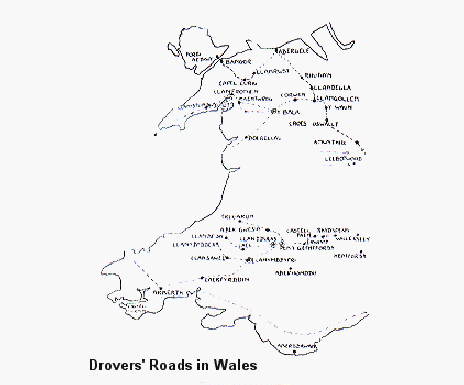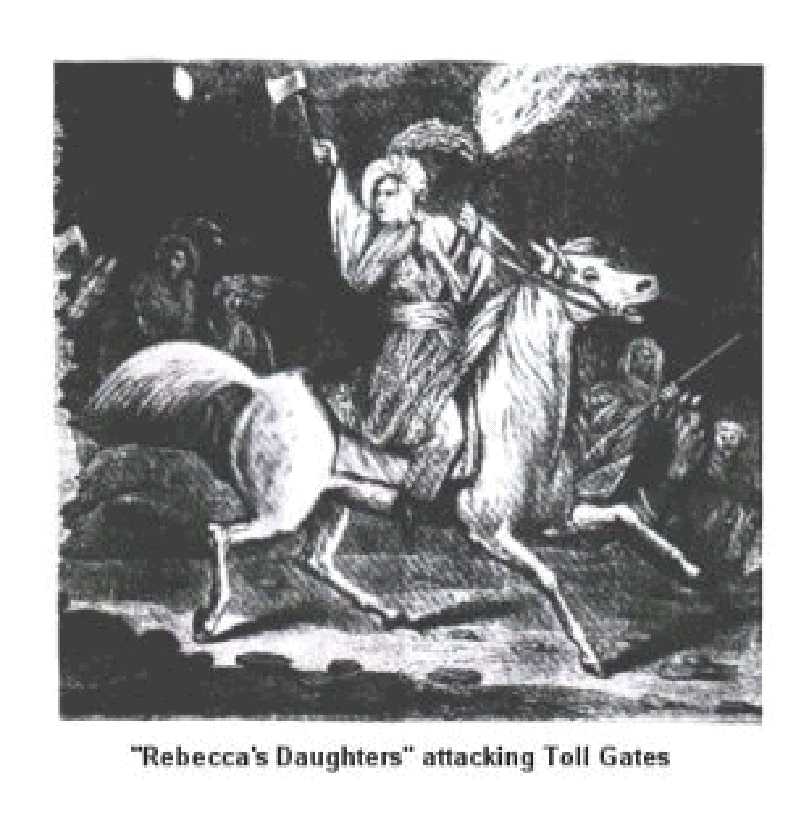|
TRAVEL IN WALES (continued)
Contents of this section
Cattle Droving
Pack Horses
The Toll Gates
Cattle Droving
How early the practice started we do not know, but during the Middle Ages, flocks
of sheep and herds of cattle were driven from the western areas of Wales as far as
the Midland towns of England and even as far as London and Kent. Distances were covered
slowly to allow the cattle to graze along the way. To save the feet and hooves of
the animals' shoes were applied by blacksmiths along the way. Even geese had their
webbed feet coated with tar and crushed oyster shell to reduce the wear and tear.
Pigs had the luxury of woollen socks with leather soles. The drovers became providers
of trade to farmers who set up rest places on their lands for overnight stops to
rest the animals and provide shelter for the cattlemen. On regular routes inns were
established, supplying food and drink to travellers. Scots pine trees were planted
at these stopping points to guide the oncoming herds. A common charge for overnight
grazing was 1/2d per animal; fields and places today still bear the name halfpenny
field.
This practice of cattle droving produced some enlightened men like Edward Morris
of Cerrigydrudion, who was a first rate poet, while Dafydd Jones of Caeo composed
many popular hymns.
Such men brought back to rural Wales not only money but also books, newsletters and
periodicals. There are many taverns in Wales and border counties with names like
'The Drovers Arms'
 A drover called Mr Bos once said to the great walker
and author George Borrow. 'I may say there are not many in Anglesey better known
in England than myself- at any rate I may say that there is not a public house between
here and Worcester at which I am not known'. George Borrow himself was a man of many
talents not the least of which was power as a linguist. He learnt Welsh as well as
many other languages. He wrote of the gipsy travellers in his books 'Lavengro' and
'Romany Rye'. In the 1860s he travelled from one end of Wales to the other sometimes
with his wife and daughter but mostly alone and on foot. His observations of Wales
during the progression of the industrial revolution are an interesting and eloquent
record of the era. A drover called Mr Bos once said to the great walker
and author George Borrow. 'I may say there are not many in Anglesey better known
in England than myself- at any rate I may say that there is not a public house between
here and Worcester at which I am not known'. George Borrow himself was a man of many
talents not the least of which was power as a linguist. He learnt Welsh as well as
many other languages. He wrote of the gipsy travellers in his books 'Lavengro' and
'Romany Rye'. In the 1860s he travelled from one end of Wales to the other sometimes
with his wife and daughter but mostly alone and on foot. His observations of Wales
during the progression of the industrial revolution are an interesting and eloquent
record of the era.
It would seem that travel was undertaken with purpose such as trade or necessity
to conduct business. Tourism or travel for pleasure was not a likely enterprise in
those days.
Most areas of population were small with few towns of more than a 1000 inhabitants.
The terrain of mid Wales has always inhibited travel because of its rough and mountainous
aspect. But this was the area where agriculture and husbandry had to be practised.
The hill farmers who had sheep or cattle for sale drove them to regular markets and
fairs. These fairs were also places where the farmers hired labour. From the inventories
of farm properties there is evidence of sledges and other forms of non-wheeled transport.
The absence of suitable roads precluded the use of wheeled carts and vehicles.
back to the
top
Pack Horses

Even much later when it was necessary to transport coal from the mining areas pack
horses or mules did this work. At the end of the 18th century steps began to be taken
to repair the roads. Men like Macadam and Thomas Telford built good roads and bridges
to enable goods and people to move more expeditiously.
back to the
top
The Toll Gates
Turnpike trusts were formed. Gates were erected and tolls were charged which
were supposed to go towards the upkeep and repair of the roads. This led to opposition
by farmers who now had to pay to move their cattle to market and bring things lime
home. In the 1830s onwards protesters dressed themselves in women's clothes and blacked
their faces. Known as Rebecca's daughters they attacked these infamous tollgates
and tollhouses, and destroyed them.
Military and police action resulted in some of these daughters of Rebecca being taken
to court and sent to penal colonies in Australia. Eventually, however local councils
were made responsible for upkeep of the roads.
 In the eighteenth century the development of copper
smelting in coastal areas around the rivers of South Wales. Principally in Swansea,
but also in Neath, merchant venturers from Bristol put up the capital to build docks
and factories. Enterprising Welshmen who had the rights to supply first timber and
then coal for the fuel of the smelting process soon followed these capitalists. Cornish
copper ore was brought to Wales by small coastal sailing ships. Coal pits in Llansamlet
supplied White Rock copper works until these mines ran out. In the eighteenth century the development of copper
smelting in coastal areas around the rivers of South Wales. Principally in Swansea,
but also in Neath, merchant venturers from Bristol put up the capital to build docks
and factories. Enterprising Welshmen who had the rights to supply first timber and
then coal for the fuel of the smelting process soon followed these capitalists. Cornish
copper ore was brought to Wales by small coastal sailing ships. Coal pits in Llansamlet
supplied White Rock copper works until these mines ran out.
The miners were displaced to other workings further west, but family tradition was
retained when any of these local miners died, the coffin would be carried on men's
shoulders thirty miles or so for burial back in the community of their birth.
back to the
top
|